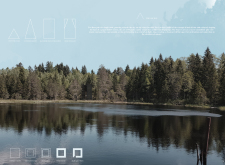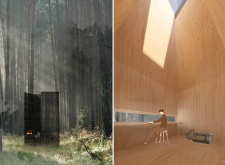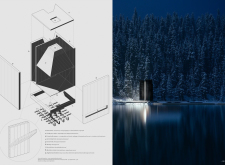5 key facts about this project
The TENT STRUCTURE features a thoughtful integration of space and cultural elements within a natural context. Serving as a place for meditation and reflection, the design fosters a strong connection between people and their surroundings. The building draws upon Latvia's rich heritage, employing geometry and the play of light to create an engaging experience that links visitors to the landscape.
Design Concept
At the core of the design is the idea of two lines converging at a single point, representing a connection to the sky. This concept is inspired by the Latvian triangle symbol, which holds deep cultural and divine significance. The pyramidal shape rises prominently from a solid base that resembles a tree trunk, creating a visual and conceptual relationship with the environment around it.
Spatial Organization
The structure includes a well-thought-out arrangement of spaces, which facilitates meditation, circulation, and service functions. Each area is clearly defined, allowing for an easy flow of movement throughout the interior. This purposeful layout invites visitors to engage meaningfully with the space, contributing to a calming atmosphere suited for personal reflection.
Materials and Construction
Materials used in the TENT STRUCTURE include protective and waterproofing layers, alongside thermal insulation designed with a slight slope for drainage. Double-pane windows made of tempered glass enhance the building's durability. The external walls are constructed from strips of pine wood and CLT laminated wood, providing both structural support and thermal efficiency. Inside, laminated plywood forms the roof and walls, while other durable wood elements contribute to the overall design.
Natural Light and Atmosphere
A central skylight serves as a key feature, allowing ample natural light to flow into the building. This design choice not only creates a warm and inviting atmosphere but also highlights the interaction between light and shadow throughout the day. The changing light enhances the feeling of calm and connection to nature, inviting users to immerse themselves in the experience.
The architectural form emphasizes simplicity and sustainability. Careful attention has been given to the details, such as the wooden framing and the carefully designed roofline, to create a tranquil space that encourages a slow pace and deep engagement with the environment.






















































